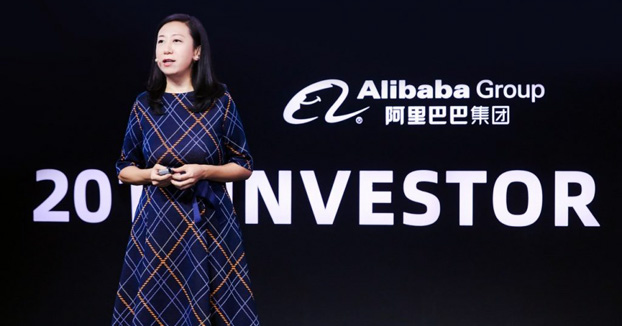Digitalisation driving retail, says Alibaba chief
- October 6, 2020
- Steve Rogerson

Digitalisation is the biggest opportunity of our time, said Daniel Zhang, chairman and CEO of Alibaba, at the Chinese retail giant’s annual investor day event.
Covid-19 and geopolitics have disrupted normal life and created uncertainties in 2020, but Alibaba Group says it is well-positioned to help merchants, consumers and economies right themselves and bounce back.
Closing out Alibaba’s annual investor day event, Zhang told approximately 1000 viewers tuning in virtually that there had been internal discussion about whether business strategy and priorities needed a revamp to restore normalcy and help economies restart after the pandemic. In the end, the decision to double down on what Alibaba has done for 21 years was straightforward.
The three-day investor event was held largely online this year to follow social-distancing protocols. Zhang spoke from Alibaba’s Hangzhou headquarters.
“In the midst of so many uncertainties, the future of digitalisation is the biggest certainty we can see,” Zhang said. “Digitalisation is the biggest opportunity of our time.”
Lessons learned during Covid and in the restart of China’s post-pandemic economy stand Alibaba in good stead to help merchants and economies around the world recover quicker. In addition, Covid sped up the process of digitalisation, with individuals and companies suddenly forced to move daily activities online. As the world emerges from Covid, Zhang said he expected some of the new behaviour would stick.
“Digitalisation is being embraced by consumers, manufacturers, retailers and brands across China’s economy,” Zhang said.
Specifically, pandemic lockdowns in China led to a surge in new consumption categories or ones that had been under-penetrated pre-Covid, including groceries, fresh foods, healthcare and wellness products. Zhang said Alibaba saw a sharp rise in online sales from those categories. The pandemic also changed how people worked and learned, Zhang noted, presenting an opportunity for Alibaba’s digital economy to provide critical infrastructure at a critical time.
The results of digitalisation speak for themselves as China continues its shift from an export and investment-driven model to a demand and consumer-driven economy. Tapping into China’s growing consumption power “is the fundamental driver of our future growth”, Zhang said.
It’s also powering present growth, with the gross merchandise volume of Alibaba’s digital economy topping $1tn in the 12 months ended June 2020, accounting for 18% of China’s total retail sales, up from 10% in 2015.
The other growth engines for Alibaba’s future are cloud computing and data intelligence and globalisation, Zhang said.
On the Alibaba Cloud front, CFO Maggie Wu had positive news for investors tuning in, telling them she expected the group’s cloud computing and data intelligence unit, which counts over three million paying customers and had revenue growth above 60% year on year in the 12 months ended June 2020, to turn profitable at some point during the 2021 fiscal year. Meantime, the group’s logistics unit Cainiao, founded only seven years ago, is expected to generate a positive operating cash flow during the fiscal year, she said.

Wu stressed Alibaba’s growth and success have come from staying true to its mission “to make it easy to do business anywhere”, innovating constantly and investing to create and build out new and necessary infrastructure, platforms, products and services.
“We have always set the first priority as helping merchants and our customers to solve their problems and to operate at higher efficiency through our technology,” Wu said. “Over the past few years, we have invested over RMB100bn each year in technology, research and development.”
She said it was key to see the components of Alibaba’s digital economy in proper perspective. Businesses Alibaba start up organically fall into the seed, traction and profitability categories. TMall and Taobao, as the main drivers of Alibaba’s core commerce operations, are older and highly profitable. They generate strong cash flow used to reinvest in businesses that are achieving traction or to incubate new businesses, either organically or via investments in businesses that build out or complement strategic needs of the digital economy.
The group had net cash of $36bn as of June 2020, along with $45bn in strategic investments, she said.
Wu gently chided investors about valuations that don’t count new or non-core commerce business operations. For example, the market has assigned very little value to Alibaba Cloud’s business or the group’s stake in Ant Group, which is preparing for a multibillion-dollar initial public offering.
“The point I want to make here is that the market is reflecting only the value of our core core-commerce businesses, and has not yet given any credit to any of our other businesses within the core,” Wu said.
Add even conservative valuations of those and other businesses into the mix, and Alibaba – which already stands out among peer technology companies, such as Facebook – stands out even more, she said.
Zhang said over the next three to five years Alibaba was focused on building out its digital economy, now with 1.07bn annual active users, moving into new consumption categories, new markets and new industry opportunities. With integrated data intelligence and customer insight, an eagerly anticipated revolution of how supply chains work is at hand.
Alibaba’s long-term goal remains to serve two billion customers, create 100 million jobs and help ten million small and medium-sized enterprises be profitable by fiscal year 2036.
It has been another year of robust growth for Alibaba’s China retail marketplaces, with especially good growth in less-developed areas.
Over the year, the marketplaces added close to 119 million MAUs, while the number of annual active consumers reached 742 million in the last quarter. More than 70% of new consumers came from China’s less-developed cities. Taobao, TMall and Alimama president Jiang Fan pointed to significant potential for user growth in the next two to three years.
Alibaba’s membership programmes, including 88VIP and Taobao Pass, are also gaining traction among consumers. These programmes had more than 30 million paying users expected as of September and have helped to strengthen customer loyalty and drive higher levels of spending.
“Consumers are increasingly looking for immersive and interactive online experiences,” Fan added, saying the focus was not just on growing gross merchandise volume, but also bringing value to customers.
“We hope our platforms will not only help merchants sell their products, but help them achieve long-term growth,” Fan said.
Supermarket chain Freshippo, Alibaba’s most successful example of new retail, reported that its annual active consumers have exceeded 25 million. It’s also expanded its footprint from 159 stores to 227 stores in the past year ending June.
Freshippo is investing heavily to develop its core competencies, from innovative technologies to procurement and merchandising. It now has more than 550 agricultural bases supplying fruit, vegetables, meat and diary, including some exclusively offered at its stores, such as premium beef from New Zealand. About 30% of its products are now procured globally by teams across North America, Europe, Japan and South Korea.
The new retail-driven supermarket has also strengthened its flagship supply chain and logistic capabilities. Beyond cold-chain warehouses and seafood storage centres, it has built more food-processing centres across the country to turn agricultural produce into marketable, standardised merchandise.
Online sales now represent 65% of Freshippo’s business, compared with 35% coming from its brick-and-mortar stores. Freshippo said it’s committed to continue innovating new store formats tailored to different consumer needs and income brackets, from its new Freshippo Mini shops designed with tier-three and tier-four city consumers in mind, to its pick-and-go stores, aimed at office workers looking to grab quick breakfast and snacks on their way to daily commutes.
Covid-19 has also accelerated the growth of Alibaba’s local services platforms, which now have a user base of over 290 million. The pandemic also led to more merchants embracing digitisation, and the platforms added more than 900 national restaurant chains and over 4000 regional chains, bringing them close to complete coverage of top-tier merchants in the country.
In July, Ele.me announced a major upgrade from delivering just food to just about anything with offerings from supermarkets, groceries, flower shops and pharmacies. With new engagement tools such as a dedicated short-form video channel, the app is also looking to go beyond an on-demand delivery platform but also a hub for discovering the world of food.
In the past year, Ele.me said it had also completed integrating its systems with Alibaba’s technological backbone, including connecting user traffic and migrating its infrastructure onto Alibaba Cloud. Currently, 45% of Ele.me’s new consumers come via the Alipay app, and it expects new consumers to come from other Alibaba apps such as Taobao and Amap. It’s also creating differentiated products through tapping Alibaba’s ecosystem, such as prepaid cards for gyms and beauty and hair salons and Foodie Cards that provide consumers with additional Huabei credit allowances up to RMB1500, so they can eat first and pay later.
Alibaba Cloud saw undisrupted growth during the pandemic. It has the largest market share in Asia Pacific and China. Alibaba Cloud now has more than three million paying customers on its cloud platform worldwide, and as Wu said, it is expected to move into profitability during the 2021 fiscal year.
Cainiao Network continues to strengthen its platform to support the flow of goods worldwide, including in its logistics hubs, line-haul routes, smart customs clearance platform, and fulfilment and supply chain technologies. During the Covid-19 pandemic, the network also played a role in delivering essential supplies around the world. According to its latest figures ending June, Cainiao has helped ship 130 million pieces of protective equipment to 150 countries and regions.




